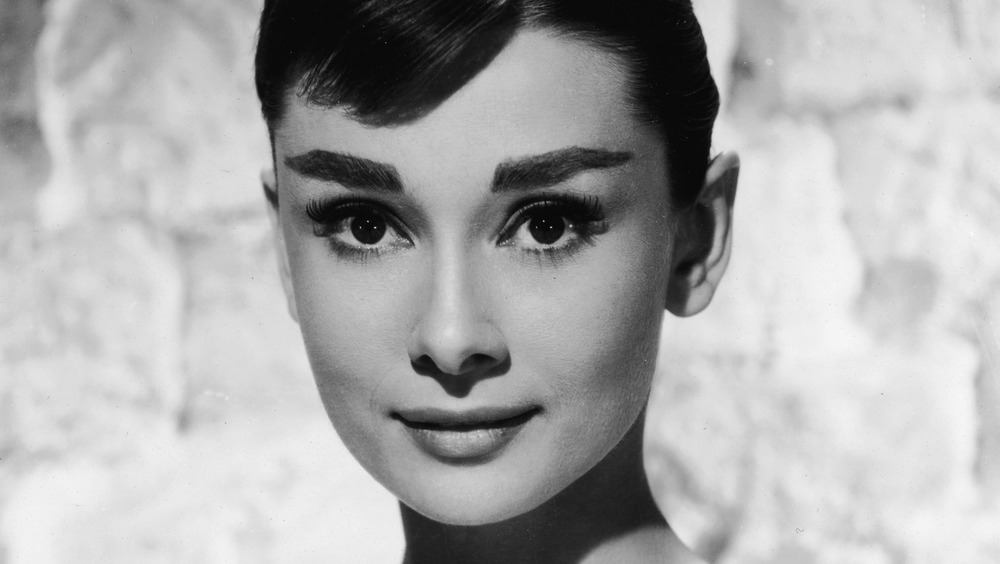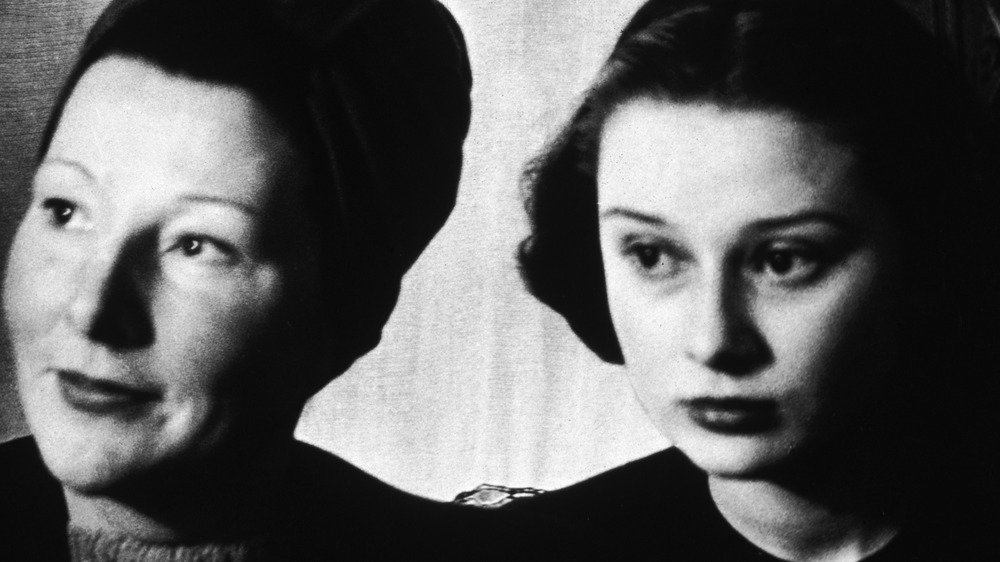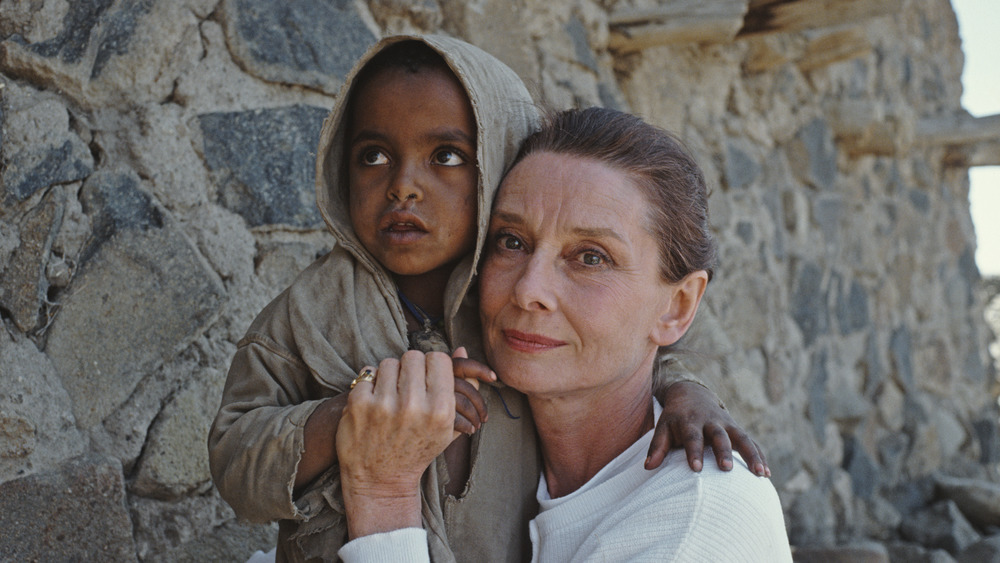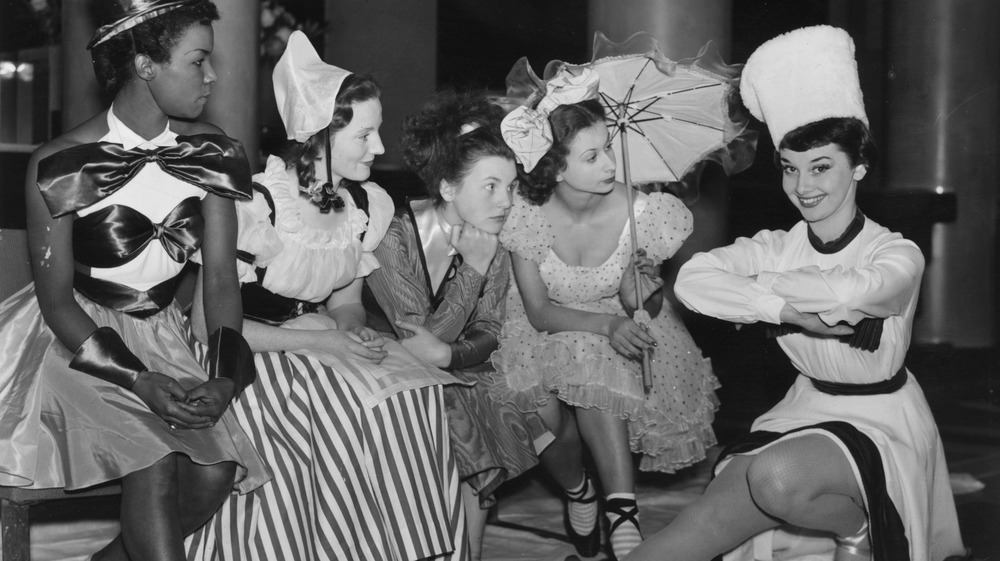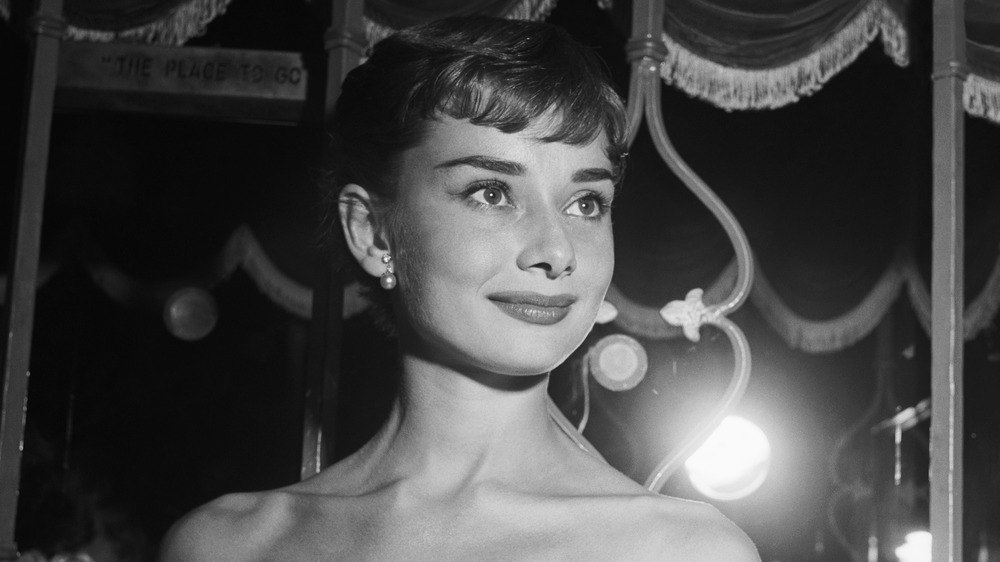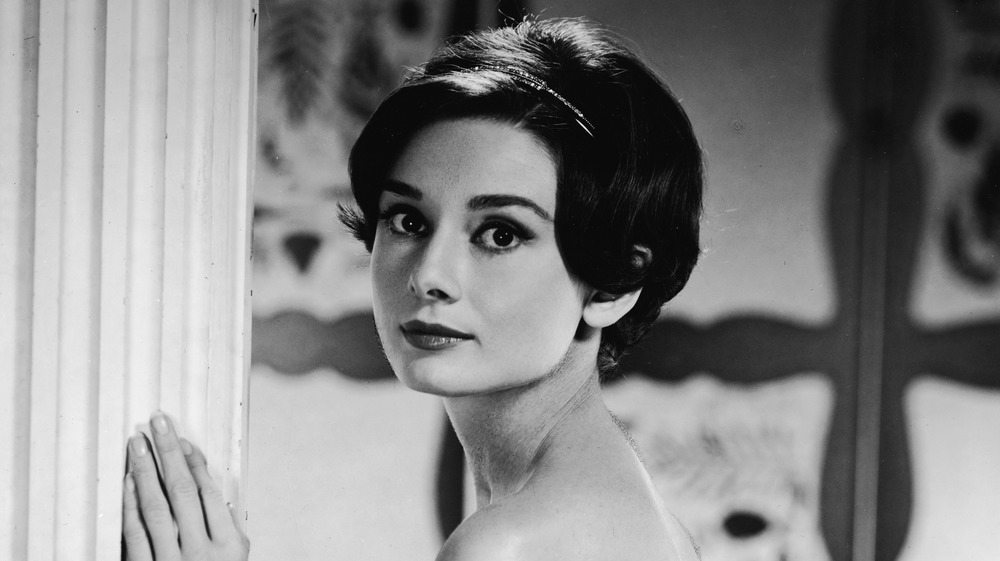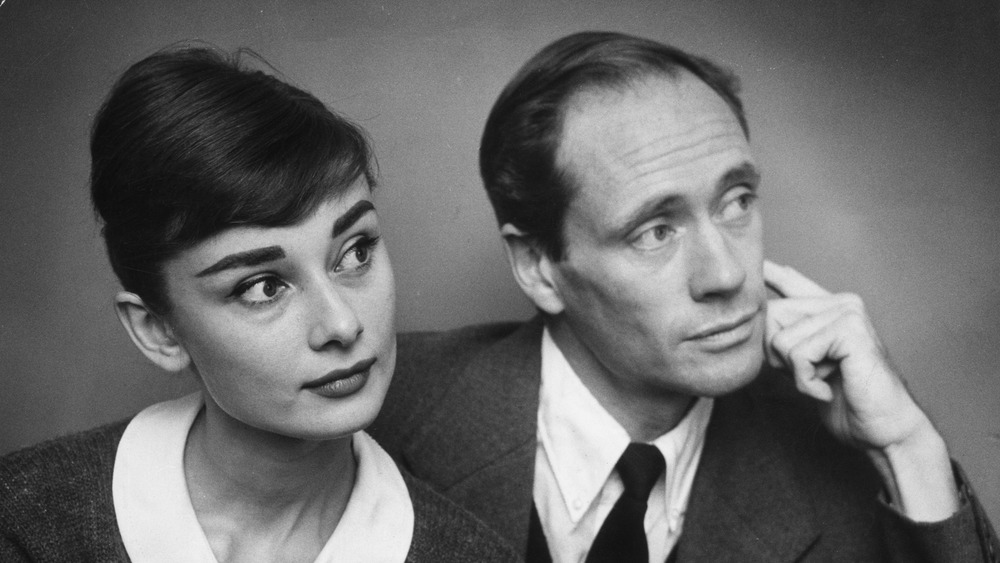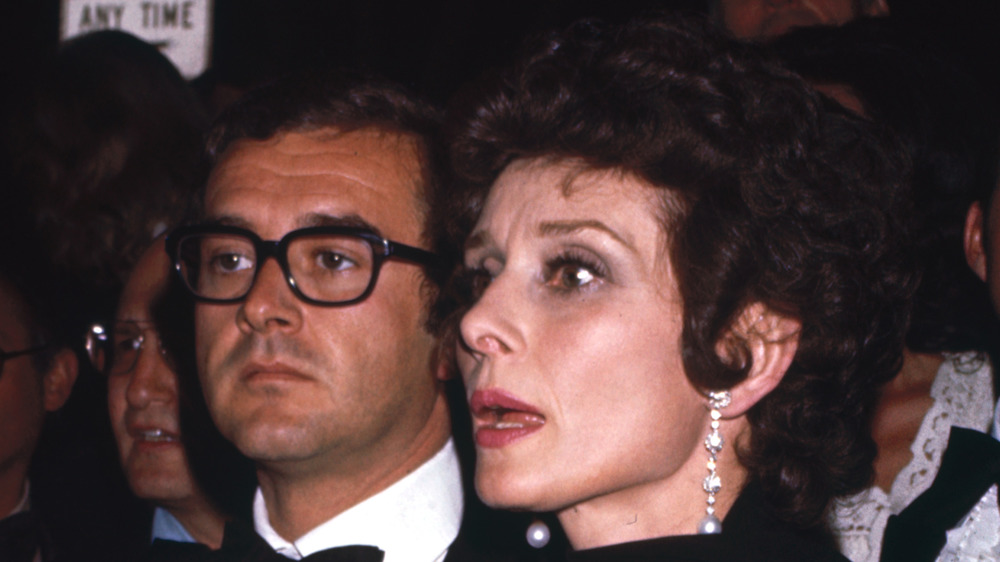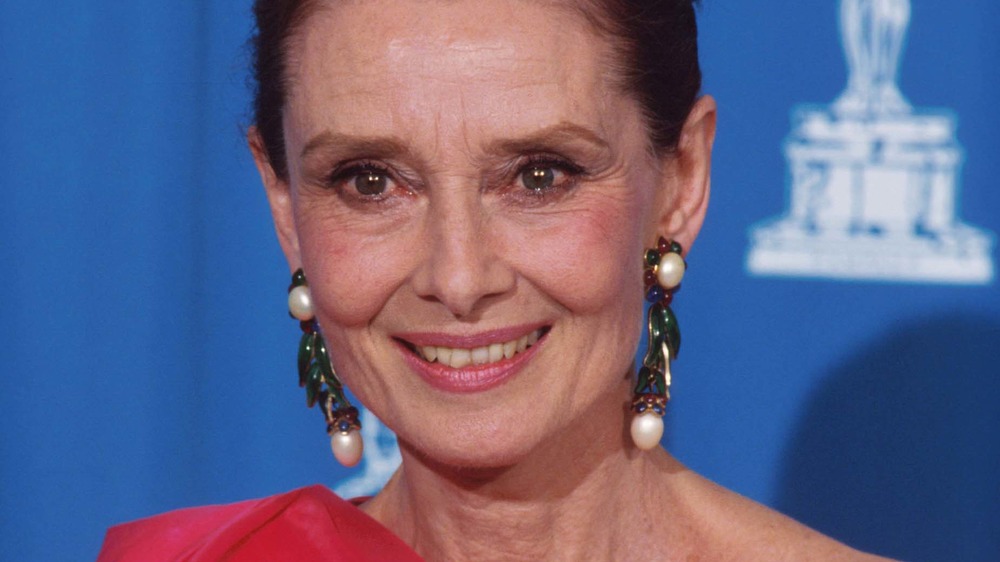Tragic Details About Audrey Hepburn
"Happy girls are the prettiest," Audrey Hepburn famously said. It's the kind of quote that appears in dorm rooms and gift shops, alongside images of Hepburn in Breakfast at Tiffany's, in a black Givenchy dress, a swirling updo, and jewels, with a slim cigarette holder in hand. Hepburn is so universally beloved that she has almost become a cliche, but even so, there's a side to the iconic actor that the typical, one-dimensional understanding of her does not show.
A 2020 documentary called Audrey, which began streaming on Netflix in March 2021, explores the darker side of Hepburn's life, with accounts from her friends and family members. "The best-kept secret about Audrey was that she was sad," Hepburn's doppelgänger granddaughter Emma Ferrer says in the doc (via The Guardian). Matters of mental health were rarely discussed, and often repressed, in Hepburn's time — particularly among famous women with aristocratic backgrounds known for their smiling charms. Still, while Hepburn was not always happy, she received most of her happiness by giving happiness away.
Audrey Hepburn's father abandoned her as a child
Audrey Hepburn was born on May 4, 1929 in Brussels, Belgium. As the daughter of Baroness Edda van Heemstra (above left), Hepburn was privileged in her early years as she traveled between European metropolises and learned six languages. According to the 2001 biography Audrey Hepburn by Barry Paris, Hepburn was extremely shy as a child, so her mother sent her to a boarding school in England when she was five years old as a form of shock therapy. Meanwhile, her parents got involved with the British Union of Fascists and worked to recruit new people to the ideology in the years preceding World War II. Then, when Hepburn was six years old, her father, Joseph Victor Anthony Ruston, abandoned the family. Hepburn once described the event as "one of the great traumas of my life," adding, "It left a very deep scar on me" (via Sky News).
After not seeing her father for decades, Hepburn discovered that he was living in Dublin, Ireland. In August of 1964, then-35-year-old Hepburn flew to Ireland to reunite with him, but they never discussed his abandonment of the family. Her son, Sean Hepburn Ferrer, told Sky News in 2020 that "she never got over the loss of her father, or let it go."
Surviving WWII had devastating effects on Audrey Hepburn
World War II broke out in 1939, when Audrey Hepburn was 10 years old. German Nazis soon occupied The Netherlands, where Hepburn was living with her mother.
While many people have admired Hepburn's thin figure over the years, many do not realize the tragic history behind it. She grew extremely malnourished during the war due to food shortages. "By the end of the war, she was very close to death," her son, Luca Dotti, told People in 2017. "She survived by eating nettles and tulip bulbs and drinking water to fill her stomach. She was almost 5' 6" and weighed 88 lbs. She had jaundice and edema. She suffered from anemia the rest of her life, possibly as a consequence."
Hepburn survived the war and the extreme hunger that came with it, but those tragic years left a permanent mark on her. "She was the same age as Anne Frank and [later] said: 'That was the girl who didn't make it and I did,'" Dotti recalled. "Her voice would crack, and her eyes would fill with tears."
Hepburn's own experience with hunger motivated her to devote her life's later years to humanitarian work in Africa as a UNICEF ambassador (shown above).
Audrey Hepburn's childhood dream of becoming a dancer was dashed
Though she became severely malnourished during the Hongerwinter — the Dutch famine that lasted from November 1944 to April 1945 — Audrey Hepburn could still dance. She put her ballet training to use and performed illegal dance recitals, in the dark and to silent audiences, to raise money for the Dutch Resistance.
In 1948, three years after the end of World War II, Hepburn won a scholarship to Marie Rambert's ballet school in London. According to Financial Times, Rambert later told her that she could not make it as a professional ballerina. "I didn't have anywhere near the technique that other girls my age had," Hepburn said later. Nor did she have the ideal ballerina proportions: She stood at five feet and seven inches, with size 10-and-a-half feet. Still, she refused to hang up her pointe shoes, even while starring in the hit Broadway play GiGi in 1951. She took ballet classes throughout the show's run, and appeared, dancing on pointe, in the drama film Secret People the following year.
When a Financial Times reporter asked ballerina Alessandra Ferri, who appeared in the 2020 documentary Audrey, if Hepburn could have made it as a dancer, Ferri replied "probably not." "Very few make it. Maybe she would have been a good dancer, [but] not a great dancer," Ferri continued. "But her mission was to give joy to the world in another way, so maybe it was lucky."
Regardless of what others thought, Audrey Hepburn was insecure about her looks
Audrey Hepburn is widely recognized as one of the most beautiful women of all time. With her slight figure, bold brows, and pixie haircut, the actor and humanitarian challenged and redefined the beauty standards of her time. Even so, Hepburn herself did not see what all the fuss was about. Her son, Luca Dotti, told Vanity Fair in 2013 that his mother thought of her own looks as "a good mixture of defects." "She thought she had a big nose and big feet, and she was too skinny and not enough breast," Dotti continued. "She would look in the mirror and say, 'I don't understand why people see me as beautiful.'"
Despite her insecurities, Hepburn reportedly enjoyed aging because it took the focus away from her appearance and toward other things she deemed more important. "She was always a little bit surprised by the efforts women made to look young," Dotti told Vanity Fair. "She was actually very happy about growing older because it meant more time for herself, more time for her family, and separation from the frenzy of youth and beauty that is Hollywood. She was very strict about everybody's time in life."
Audrey Hepburn suffered several miscarriages
Reports about Audrey Hepburn's pregnancies vary, including claims that she suffered several miscarriages, starting in 1955 and ending in 1974 — the most high profile of which happened in 1959 while filming the western movie Unforgiven. One day early in her pregnancy, Hepburn fell off a horse on the movie's set, and the injury resulted in the loss of the pregnancy. But before long, she was pregnant again, and as the months went by she learned she was pregnant with a girl. Then, six months into the pregnancy, she miscarried again due to a then-unknown cause.
Author Barry Paris quoted Hepburn in his biography, Audrey Hepburn, as saying, "My miscarriages were more painful to me than anything ever, including my parents' divorce and the disappearance of my father." Thankfully, Hepburn went on to have two sons: She welcomed Sean in 1960, and Luca in 1970.
"What happens is exponential — the first [miscarriage] is a tragedy and the second one is not just another tragedy, but it gets you so many more miles away from thinking that you'll ever be able to have a child," Hepburn's oldest son, Sean Hepburn Ferrer, said in an interview with Sky News. "And there was no explanation. People didn't know about incompetent cervix or about any of that in those days... We all came from a culture of you got to keep moving, you got to keep doing."
Audrey Hepburn's first husband reportedly 'ruled her with an iron fist'
In December 1953, then-24-year-old Audrey Hepburn's Roman Holiday co-star Gregory Peck introduced her to the 36-year-old fellow actor Mel Ferrer. "Our very first meeting was in London, at a film party, and it was very formal," Hepburn later told an interviewer (via Express). "The thing I remember most about that first meeting was that I thought he was so serious. He didn't smile." Shortly thereafter, Ferrer sent Hepburn the script for a play called Ondine, and within a month of their first meeting, they were in rehearsals together. The following September, the pair got married in Switzerland and honeymooned in Italy.
Throughout their marriage, many observers thought Ferrer was overly controlling of Hepburn and her career. Director Michael Powell once said that Ferrer had "no warmth, nothing to give. Clever, yes — kind, no," while director Alfred Lund said that "Ferrer used Audrey's crush on him to rule her with an iron fist" (via Express). The couple divorced in 1968, after 14 years of marriage. "I can't tell you how disillusioned I was," Hepburn later said, according to biographer Barry Paris' Audrey Hepburn, "I'd tried and tried."
Still, it was good news for Hepburn's mother, Edda van Heemstra, who reportedly loathed Ferrer. According to People, she once called him "[the] frog faced delinquent with the spindly legs." Decades later, Hepburn biographer Diana Maychick (via The Telegraph), "It ate away at me that they couldn't get along."
Andrea Dotti reportedly cheated on Audrey Hepburn countless times
In 1969, Audrey Hepburn married Italian psychiatrist Andrea Dotti. During a 2020 interview with The Sun, her son, Sean Hepburn Ferrer, recalled Dotti as being a "fantastic" stepfather. But while Hepburn was pregnant with her and Dotti's only child, a son named Luca, her husband was often out on the town. Throughout their 13-year marriage, he was spotted with approximately 200 other women. The couple's maid revealed Dotti's infidelities to Hepburn, telling the star that Dotti would often bring women home with him while Hepburn was abroad. "She was as delicate as she could be and my mother had suspicions already," Hepburn Ferrer told The Sun, "and this was the Sixties sexual revolution."
Hepburn Ferrer was just 12 years old at the time. "I knew there was difficulty," he recalled. "My mum sat me down with bloodshot eyes, told me what was going on and asked me what I thought. I was a kid. I did not know how to help her." Once the marriage officially ended in 1982, Hepburn remained in Italy so Dotti could see his son and stepson, but according to Hepburn Ferrer, Dotti didn't make the effort to see him.
Hepburn later moved to Switzerland and found love with fellow Dutch actor Robert Wolders.
Audrey Hepburn died of appendix cancer at age 63
In 1992, Audrey Hepburn was awarded the Presidential Medal of Freedom, according to History. The same year, the actor and humanitarian was diagnosed with cancer of the appendix. "The doctors gave her three months to live," said her longtime partner, Robert Wolders, in an interview with People. "She acknowledged being afraid of the pain but not being afraid of dying." Even after her diagnosis, Hepburn continued her humanitarian work for UNICEF. At the end of the year, she was determined to spend her last Christmas at home in Switzerland with her family, and when she went to bed that night, she deemed it "the most beautiful Christmas I ever had."
Hepburn died in Switzerland on January 20, 1993, at the age of 63. She was posthumously awarded the Jean Hersholt Humanitarian Award at the 1993 Oscars. "She had this ability to make everyone who met her feel that she was really seeing them, and recognizing what was special about them," her friend, the composer Michael Tilson Thomas, also told People. "Even if it was just in the course of the few moments that it takes to sign an autograph, and a program. There was a state of grace about her. Somebody who is seeing the best in a situation, seeing the best in people."
Fittingly, Hepburn's final onscreen role was in Steven Spielberg's 1989 film Always, playing — per History — "an angel guiding the movie's protagonist to heaven."

